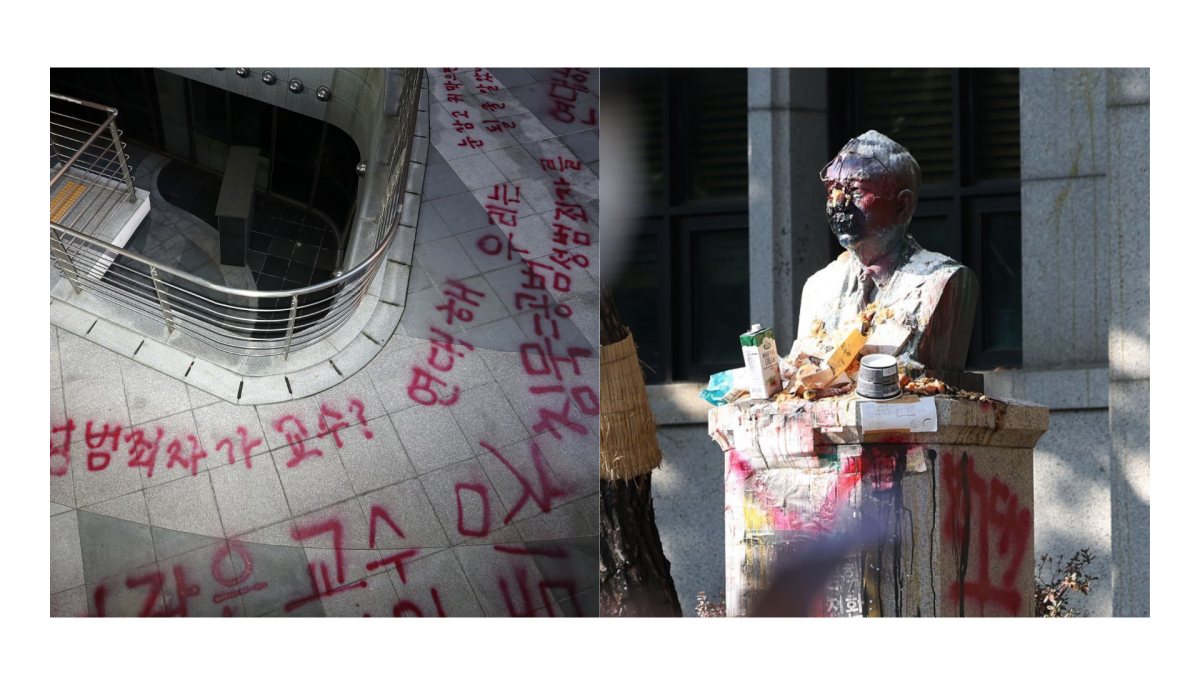How loud must a voice become to be heard in the face of justice? History shows us that quiet discontent often dissolves into silence, bringing no change. Yet, when students destroy buildings, when signs transform into shouts, and when peaceful demonstrations escalate into confrontational stands, society asks if such actions remain justified. This struggle between the right to be heard and the means of being heard has emerged once again in South Korea.
Over 500 students at Seoul Women’s University rallied in front of the Nowon Police Station to stage a “lacquer protest” on Nov. 19. Lacquer protests refers to protests where lacquer or paint is sprayed on places such as wood, cement, or stone as a form of demonstration. The incident that sparked this protest was when the university imposed a three-month salary decrease as punishment for a professor who sexually harassed students in September last year. Students only became aware of this in September this year and expressed their discontent, arguing that the punishment was too lenient.
To demonstrate their anger, students initially put up hand-written posters demanding a public apology from the school, separation of the perpetrator from the victims, and stronger measures to protect the victims. However, the professor filed a defamation lawsuit last month against three students who had publicly criticized him. His lawsuit ignited mass fury among students.
The students saw no other way of being heard; the existing system failed the victims twice—first through the abuse itself, then through the protection of the abuser. Vulnerable victims were left to cope with their pain alone in an institution determined to silence the victims. Every day, students had to share the same campus as their abusers, leaving their grades and futures in the hands of the perpetrator.
In such contexts, disrupting the status quo seems to become less of a choice and more of a last resort—they become entitled to “self-defense” in asserting their rights.
The effectiveness of such protests is undeniable. This protest achieved what months of peaceful efforts could not—the media finally turned its gaze toward the injustice, and the public began to listen. The pressure ultimately worked: the professor resigned from the university on Nov. 20.
History suggests that many of the rights and freedoms we take for granted today were won through these violent struggles. Without these acts of resistance, society risks stagnation, continuing the systemic injustices.
Still, this does not mean that these disruptive protests are always justified. The unconditional notion of “end justifies the mean” is dangerous, as the Dongduk Women’s University protest warns.
Their protest was incited by Dongduk University’s decision to transition to a co-ed institution, given Korea’s decreasing population—a seemingly valid move. However, students were outraged by their lack of representation in the decision-making process. Many believed that a traditional women’s university should remain as it is.
The protests at Dongduk escalated into violence and destruction, raising voices that the harm caused may have outweighed the intended benefits. Students have damaged facilities, causing an estimated damage of up to 10 billion won. Due to the disruption of classes, more than 300 lectures per day had to be replaced with online classes. Furthermore, the atmosphere of fear surrounding the protest severely limited freedom of expression. Students who chose not to participate were subjected to verbal abuse and even violent threats.
This demonstrates that the effectiveness and legitimacy of disruptive protests depend on their execution. Poorly managed protests risk attracting negative media attention and public backlash. At Dongduk, students now face the stigma of being associated with violence, which will severely harm their future job prospects after graduation.
Protests are meant to voice concerns and push for change, but when they start to infringe on the rights of others, they lose their validity. Misdirected violence may only undermine its very own purpose and result in greater harm in the long run, as shown by Dongduk’s protest. Instead of fostering change, the protests have only prevented dialogue, creating a wider gender divide and chaos within the university and society.
The legitimacy of these disruptive protests ultimately depends on whether they are proportional, necessary, and in pursuit of a just cause. Protests must strive not just to be heard but to inspire meaningful change, ensuring their actions align with their goals.


